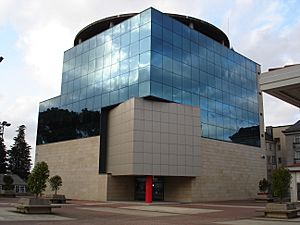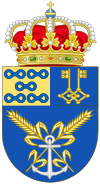Narón facts for kids
Quick facts for kids
Narón
|
|||
|---|---|---|---|
|
Municipality
|
|||

Town Hall
|
|||
|
|||
| Nickname(s):
Terra de Trasancos
|
|||
| Country | |||
| Autonomous community | |||
| Province | A Coruña | ||
| Comarca | Ferrolterra | ||
| Area | |||
| • Total | 66.91 km2 (25.83 sq mi) | ||
| Population
(2018)
|
|||
| • Total | 39,115 | ||
| • Density | 584.59/km2 (1,514.08/sq mi) | ||
| Time zone | UTC+1 (CET) | ||
| • Summer (DST) | UTC+2 (CEST) | ||
Narón is a lively town in northwestern Spain. It's part of the autonomous community called Galicia. Narón is very close to the Atlantic Ocean, which means it has a special climate. The city of Ferrol is only 5 kilometers away. You can easily travel between Narón and Ferrol by train or bus. The closest airports are in A Coruña and Santiago de Compostela.
Contents
Narón's Weather: An Ocean Climate
Narón has an Oceanic climate. This is because it's so close to the Atlantic Ocean. The weather here is usually mild. It has many rainy days, but it doesn't get too hot in summer or too cold in winter.
Fun Things to Do in Narón
Narón offers many activities for entertainment and culture.
Cultural Centers and Theatres
The town has two main cultural centers. There's a large theatre with over 1000 seats. There is also a smaller auditorium for different performances.
Shopping and Movies
You can find a big shopping center called Centro Commercial Odeón. It has a 12-screen cinema, perfect for watching the latest movies.
Nightlife Areas
For older teens and adults, Narón has two popular nightlife areas. These are Carretera de Castilla and A Gándara. Both places are full of pubs, music venues, and traditional restaurants.
Festivities and Celebrations
Narón loves to celebrate! Many special days are marked throughout the year.
May Day and Galician Literature
In May, people celebrate May Day on the 1st. On May 17th, it's Galician Literature Day. This day honors the rich history of Galician writing.
August's Oenach Festival
In August, Narón holds an Oenach. This festival remembers the town's ancient Celtic roots. It's a fun way to connect with history.
Día de Narón and National Day
Every year on November 23rd, Narón celebrates its own special day, the Día de Narón. On July 25th, the town celebrates the National Day of Galicia. This day includes concerts and parties in the main town square, Galician Square. Narón also observes all the national Spanish holidays.
Narón's Neighborhoods and Parishes
Narón is divided into 13 areas called parishes (Parroquias). These are like different neighborhoods.
Main Urban Areas
Six of these parishes are now part of the city center. These include Pinheiros, O Couto, A Gándara, Outo do Castiñeiro, Xuvia, and A Solaina. They are known as urban neighborhoods.
Important Localities
Narón has 195 smaller areas called localities. The biggest ones are A Gándara, A Solaina, and Piñeiros. Each of these has more than 6,000 people living there. The Narón town hall is located in Outo do Castiñeiro.
Learning in Narón: Schools and Education
Narón has many schools for young people. There are four public Infant Schools for the youngest children. For older students, there are six public Primary Schools and two Public Secondary High-Schools. The town also has fourteen private schools.
Languages Spoken in Narón
In Narón, people speak two main languages: Castilian Spanish and Galician. While many people speak Castilian as their first language, children in school are taught in Galician. If you visit, you'll notice that most official signs and information are in Galician.
Narón's Economy: How People Make a Living
Narón's economy is mainly focused on services and industries.
Main Economic Activities
The biggest parts of the economy are the service sector (like shops and offices) and the industrial sector (factories). These two areas employ most of the working people. Narón is a good place for small industries to grow.
Industrial Parks
The Río do Pozo industrial estate is one of the largest business parks in Galicia. Big companies like Pull and Bear and Lidl have facilities here. Another important industrial area is A Gándara.
Key Industries
Narón is home to important companies in the iron and steel industry, like MEGASA and POLIGAL. Other industries include dairy products, thermal insulation, electricity, electronics, construction materials, food, and distilling.
A Look at Narón's Economic History
Narón's industrial growth started centuries ago. Early factories made leather, textile mills, and used water mills. Later, tile factories, shipyards, and sawmills became important. Today, you can still find workshops for woodwork, stone, leather, and ceramics.
Farming and Agriculture
The smallest part of Narón's economy is farming. Farmers grow cereals, potatoes, and vegetables. They also raise cattle. This activity helps support the local economy.
Growth and Development
Narón has grown steadily since 1900. This growth sped up in the 1960s and 1970s. This was due to the success of the naval industry in nearby Ferrol and Fene. Many people moved to Narón from rural areas of Ferrolterra and other parts of Spain. This brought new life to the town and helped the construction industry grow.
Modern Changes
After an economic slowdown in the 1980s, Narón saw new growth in the 21st century. New motorways, wind farms, and business parks like Río do Pozo helped. The town has also improved its urban areas, burying power lines and building new developments. Buildings are usually four or five floors high, but some new ones are taller.
Narón's History and Culture
Narón has a long and interesting history, with signs of human life from ancient times.
Ancient Times
Evidence like Megalithic remains and ancient hill-forts (called castros) show that people lived here long ago. These sites are found in areas like A Moura, San Mateo, and O Val.
Medieval Monasteries
In the Middle Ages, small monasteries were important. The most significant were San Martiño de Xuvia and San Salvador de Pedroso. These monasteries were centers for economic, cultural, and religious life.
Historic Landmarks
You can visit the Presa do Rei at the Xubia river. There are also two water mills from the 18th century. These mills have great historical value.
The Romanesque Church of O Couto
The most famous monument in Narón is the Romanesque Church of O Couto. It's part of the old monastery of San Martiño de Xuvia and dates back to the 12th century. The church has a special design with three main sections and rounded ends. Inside, you can see the Gothic tomb of Rodrigo Esquío. The front entrance and tower were added later, in the 18th century. This church is a beautiful example of different architectural styles blended together.
Modern Challenges and Culture
Today, Narón is working to improve its cultural offerings. Like many towns, it has faced economic challenges. However, it continues to develop and grow its community and culture.
See also
 In Spanish: Narón para niños
In Spanish: Narón para niños



